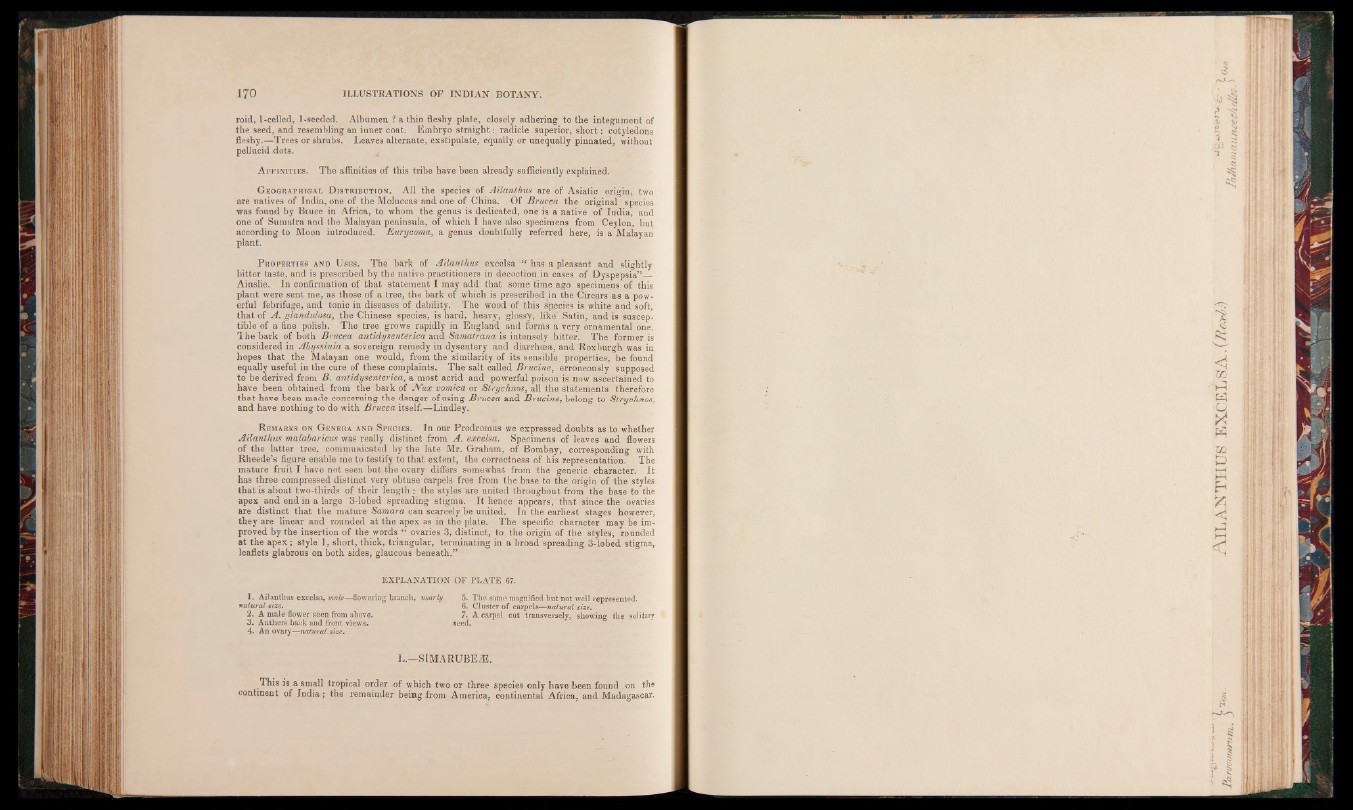
roid, 1-celled, 1-seeded. Albumen ? a thin fleshy plate, closely adhering to the integument of
the seed, and resembling an inner coat. Embryo straight: radicle superior, short: cotyledons
fleshy.—Trees or shrubs. Leaves alternate, exstipulate, equally or unequally pinnated, without
pellucid dots.
Affinities. The affinities of this tribe have been already sufficiently explained.
G eographical Distribution. All the species of Ailanthus are of Asiatic, origin, two
are natives of India, one of the Moluccas and one of China. Of Brucea the original species
was found by Bruce in Africa, to whom the genus is dedicated, one is a native of India, and
one of Sumatra and the Malayan peninsula, of which I have also specimens from Ceylon, but
according to Moon introduced. Eurycoma, a genus doubtfully referred here, is a Malayan
plant.
P roperties and Uses. The bark of Ailanthus excelsa has a pleasant and slightly
bitter taste, and is prescribed by the native practitioners in decoction in cases of Dyspepsia”_
Ainslie. In confirmation of that statement I may add that some time ago specimens of this
plant were sent me, as those of a tree, the bark of which is prescribed in the Circars as a powerful
febrifuge, and tonic in diseases of debility. The wood of this species is white and soft,
that of ^4. glandulosa, the Chinese species, is hard, heavy, glossy, like" Satin, and is susceptible
of a fine polish. The tree grows rapidly in England and forms a very ornamental one.
The bark of both Brucea antidysenterica and Samatrana is intensely bitter. The former is
considered in Abyssinia a sovereign remedy in dysentery and diarrhoea, and Roxburgh was in
hopes that the Malayan one would, from the similarity of its sensible properties, be found
equally useful in the cure of these complaints. The salt called Brucine, erroneously supposed
to be derived from B. antidysenterica, a most acrid and powerful poison is. now ascertained to
have been obtained from the bark of JYux vomica or Strychnos, all the statements therefore
that have been made concerning the danger of using Brucea and Brucine, belong to Strychnos,
and have nothing to do with Brucea itself.—Lindley.
R emarks on Genera and Species. In our Prodromus we expressed doubts as to whether
Ailanthus malabaricus was really distinct from A. excelsa. Specimens of leaves and flowers
of the latter tree, communicated by the late Mr. Graham, of Bombay, corresponding with
Rheede’s figure enable me to testify to that extent, the correctness of his representation. The
mature fruit I have not seen but the ovary differs somewhat from the generic character. It
has three compressed distinct very obtuse carpels free from the base to the origin of the styles
that is about two-thirds of their length : the styles are united throughout from the base to the
apex and end in a large 3-lobed spreading stigma. It hence appears, that since the ovaries
are distinct that the mature Samara can scarcely be united. In the earliest stages however,
they are linear and rounded at the apex as in the plate. The specific character may be improved
by the insertion of the words “ ovaries 3, distinct, to the origin of the styles, rounded
at the apex; style 1 , short, thick, triangular, terminating in a broad spreading 3-lobed stigma,
leaflets glabrous on both sides, glaucous beneath.”
EXPLANATION OF PLATE 67.
1. Ailanthus excelsa, male—flowering branch, nearly 5. The same magnified but not well represented.
natural size. 6. Cluster o f carpels—natural size.
2. A male flower seen from above. 7- A carpel cut transversely, showing the solitary
3. Anthers back and front views.' seed.
4. An ovary—natural size.
L.—SIMARUBEÆ.
This is a small tropical order of which two or three species only have been found on the
continent of India; the remainder being from America, continental Africa, and Madagascar.